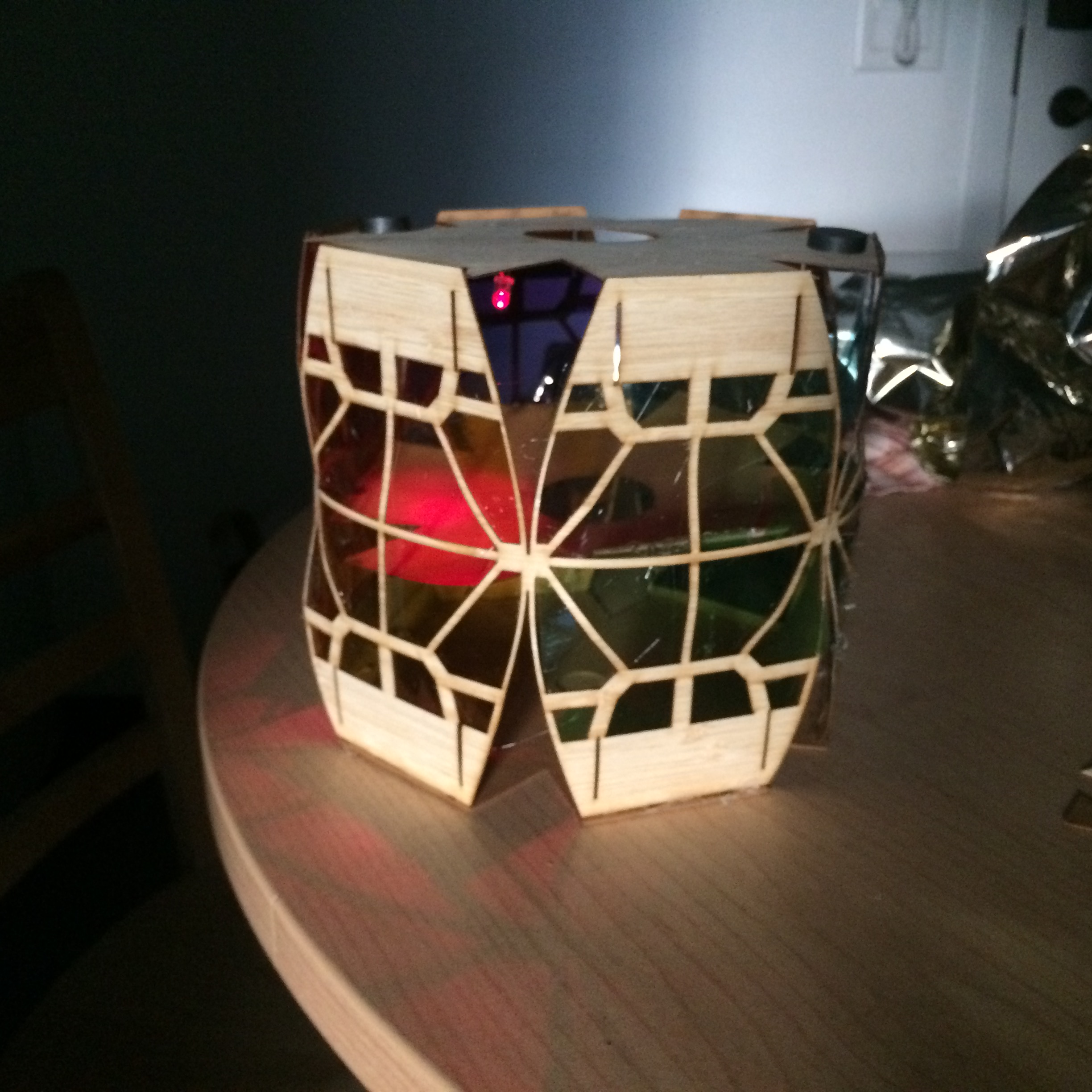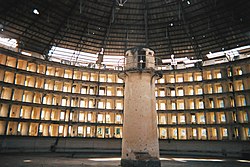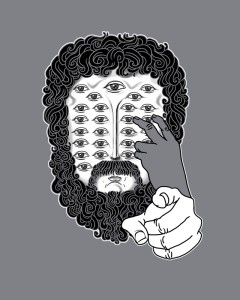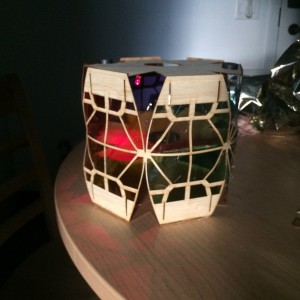
from wiki:
The Panopticon is a type of institutional building designed by the English philosopher and social theorist Jeremy Bentham in the late 18th century. The concept of the design is to allow all (pan-) inmates of an institution to be observed (-opticon) by a single watchman without the inmates being able to tell whether or not they are being watched. Although it is physically impossible for the single watchman to observe all cells at once, the fact that the inmates cannot know when they are being watched means that all inmates must act as though they are watched at all times, effectively controlling their own behaviour constantly. The name is also a reference toPanoptes from Greek mythology; he was a giant with a hundred eyes and thus was known to be a very effective watchman.
panoptic prison in Cuba.
Funnily enough, when describing his design, Bentham mentions a lot about light and windows- calling for venetian blinds in the observer’s window ports, naming the hiding spots for the observer “blinds”, & describing the whole structure as a “glass lantern”.
simply, a panopticon is a structure which allows everything within to be watched by one observer.
the idea of the panopticon plays off emerging issues of privacy in times of big data and the implementation and use of technologies like drones, CCTV, fitness trackers, etc. With our each step documented, our information is amassing for the giants at the center to see (corporations, companies, governments).
In 1965, American historian Gertrude Himmelfarb published an essay, “The Haunted House of Jeremy Bentham”, in which she called Bentham’s panoptical structure dreams of surveillance as a tool of oppression and social control. Michel Foucault wrote of them as well, saying:
“The Panopticon creates a consciousness of permanent visibility as a form of power, where no bars, chains, and heavy locks are necessary for domination any more.”
(Panoptes, mythical Greek giant w/ 100 eyes )
My lamp is a panopticon of light. The light is imprisoned inside, held in symbolically by the triangulater/ trapezoidal bars on each window, and also physically by the lighting gels. The light may be imprisoned but it is not completely invisible to the outside world- shadows are still emitted from the lamp.
This reaches out to a further metaphor about imprisonment in general- the person may be put away, but their absence is still very noticeable. [ in America, 1 in 8 black men are in jail. All those fathers, brothers, husbands, friends, are removed from society. It is noticeable.]
The solution to this oppressing issue is transparency: our “overseers” must be transparent in their intent, reasons, and every other step imaginable. In this new age of information, transparency is proving to be the most generous and secure way of moving about our world [open source materials, collaboration].
Panopticons are about power. Although they have been proposed for schools, hospitals, & other centers of habitation, the design was intended for a jail. Only one overseer makes security a lot more affordable. Bentham himself described the Panopticon as “a new mode of obtaining power of mind over mind..”
Privacy// power, freedom // imprisonment – These were the dualities I chose to work with.
—————————-
“Freedom is no fear” – Nina Simone
Light is possibly the freest thing in our universe. It is a visible yet invisible electromagnetic radiation. We acknowledge its speed and presence in most of the reaches of the universe we know about, and its huge contribution to the existence of life in general.
The overseer of light in this panopticon is a magnet. The magnet switch allows the light to bounce around, or shuts it off. The relationship between light and magnetism is something I played with in the concept of this piece- light is made of electric and magnetic fields that change very rapidly.
—————————-
The Lamp
BOM:
LEDs
Copper Tape
Paper or the very thin wood (1/8 inch or less)
Lighting Gels (I used a sample book I picked up at a lighting store)
3V batteries
Coin cases for 3V batteries
Solder & Soldering Tools
Hot Glue + Gun
Laser Cutter
Inspiration/ Prior art & Precedents: I read Ji Qi’s thesis: The fine art of paper electronics, where she explains:
“the Kit-of-No-Parts approach, which views electronics as a craft. Instead of relying on standard electronic components and techniques, electronics can be made with a diversity of materials and express the creativity of its makers [Per12].Graphite pencils can be used to make paper potentiometers and Velostat, a plastic film whose conductivity changes with pressure, is useful for making pressure and bend sensors. Phototransistors are good for sensing surrounding light levels and Hall effect sensors, which sense the presence of permanent magnets, can be used as a simple method for reading close-range proximity.Magnets are also useful for maintaining mechanical connections in circuits. Electret microphones provide a cheap and compact way to sense surrounding sound levels, as well as wind. Finally, a piezoelectric buzzer acts as a very light and thin speaker element.”
She is so creative with materials!
Jennifer Jacob’s processing library was a godsend. The Codeable Objects library for Processing allows the user to design beautiful lamps and export laser-cutter ready designs.

examples of Codeable Objects lamps^
I decided to work with paper for the project, & set out on some folding & cutting experiments:
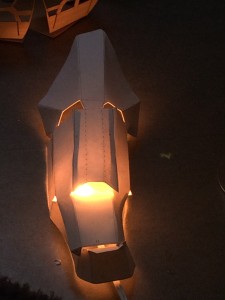
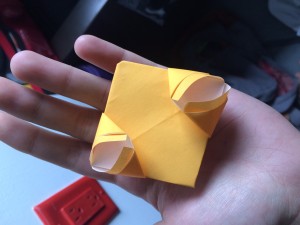
I also thought a lot about the color red. Red is the light at the edge of the visible spectrum- it has the longest wavelength. Wavelengths longer than the classic red bleed into Infared- which is invisible to us. Red shift is an astrological/ physics phenomenon in which things appear red in space as they move away from us. I ended up using Red leds as the “prisoners”.
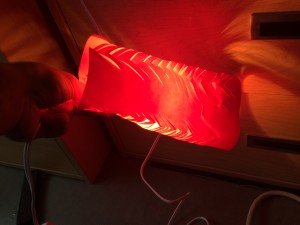
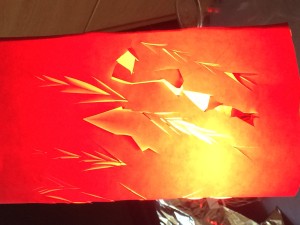
Playing with leaks and textures.
After experimenting, ( and a little processing troubleshooting) I made a few models with the Codeable Objects library.
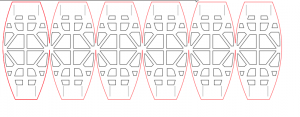 the file
the file
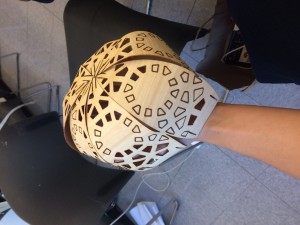 a discarded version
a discarded version
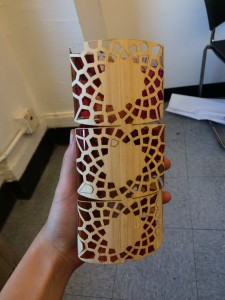
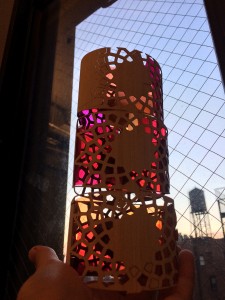
Test with some Gels in the sun
I printed them using the laser cutter:
Constructing the circuit & Switch!
I put copper tape down from the positives and negatives of the battery and soldered at the spots where I tore them for the corners. The green dashes are the negative strip. I used two batteries to light the leds, and four magnets for the switch. A strip of copper tape was added to the magnets so they’d lock the circuit closed when in place.
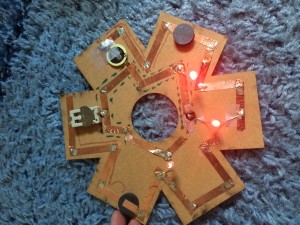
Filling in the gaps with the light gels.
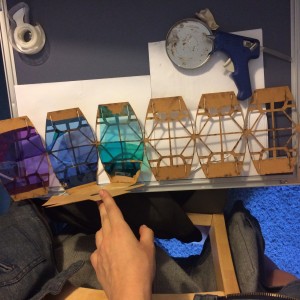
After the gels are added, hot glue that baby shut!
bibliography:
The Fine Art of Electronics: Paper-based Circuits for Creative Expression Jie Qi BS in Mechanical Engineering Columbia University, May 2010 ARCVES MACHTTS NSTITUTE – – 2 2′ 2 !7,) F I Submitted to the Program in Media Arts and Sciences, School of Architecture and Planning in Massachusetts Institute of Technology, September 2012. © Massachusetts Institute of Technology 2012.
http://highlowtech.org/?p=2329
http://science-edu.larc.nasa.gov/EDDOCS/electric.html
https://en.wikipedia.org/wiki/Panopticon



